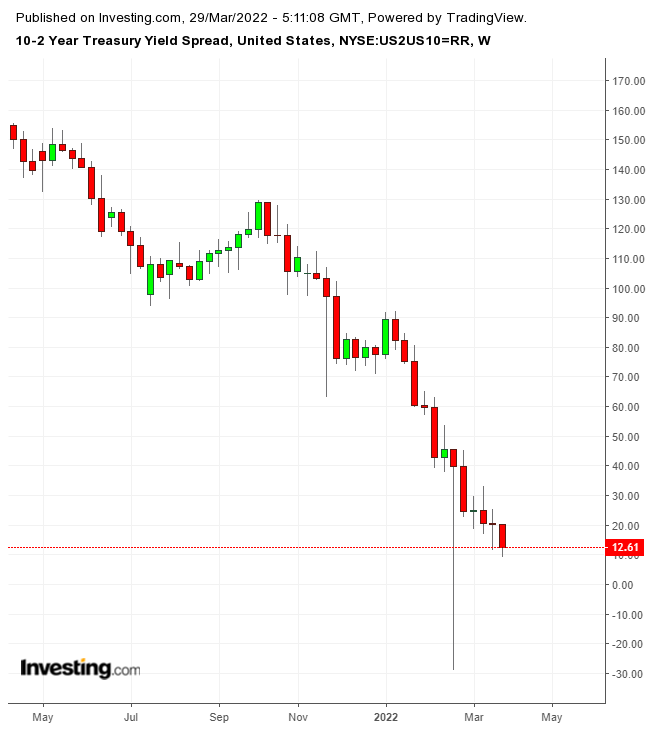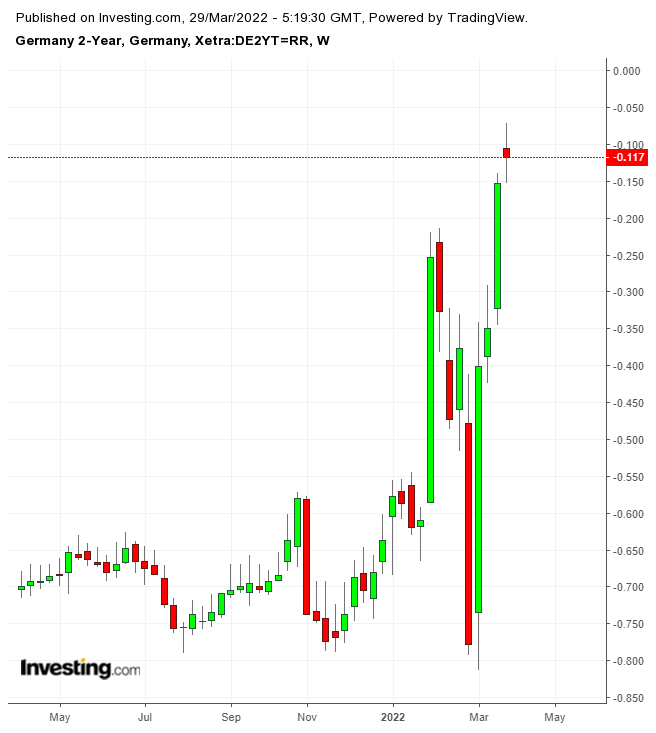Bubble or no bubble, this is the best stock for AI exposure: analyst
The yield curve on US Treasuries is flattening, and on Monday, yield on the 5-year was higher at one point, 2.64%, than on the 30-year bond at 2.57%.
This inversion is not the most watched for signs of a looming recession, but it got noticed. Meanwhile, the more closely watched gap between 2-year and 10-year note yields narrowed to just 12 basis points, threatening to invert as investors dumped US government bonds.

Still, yields receded slightly during Monday trading after the selloff on Friday amid signs that the Federal Reserve was ready to get more aggressive in tightening monetary policy. Several Fed policymakers last week said it might be necessary to raise the overnight federal funds rate in half-point increments rather than the gradual quarter-point hikes investors have been anticipating.
Yield curve inversion is an imprecise indicator, especially when the Fed is buying bonds and other distortions can interfere with price signals. Some analysts noted that the gap between the 3-month Treasury bill and 10-year note yields has been increasing, signaling economic expansion rather than retraction.
But forecasters have started predicting an inversion of the crucial 2-year, 10-year yield sometime this year, maybe as soon as three months. Some are arguing that inversion this time will be different because of the Fed’s bond-buying during the pandemic, or simply because history is not always a guide.
The Fed has not inspired any confidence in its predictive ability, however, after completely missing the boat on the impact of inflation. Policymakers weren’t counting on Russia invading Ukraine, but that’s why central banks historically tend to react preemptively, while they have time to steer things in the right direction.
Sovereigns Selloffs Advance As Investors Seek Greater Returns
What history can’t help us with so much is the impact of the Fed running off its bond portfolio—the so-called quantitative tightening as it stops reinvesting the proceeds from maturing bonds. Fed Chairman Jerome Powell has said that the minutes of the Mar. 15-16 policy meeting, due out Apr. 6, will show some discussion of a timetable for this process.
The Fed buying fewer Treasuries could put pressure on yields as investors seek bigger rewards. With inflation at its current high levels, real yields are significantly negative, which most analysts consider not sustainable for any length of time.
Europe is experiencing its own government bond selloff as investors look for the European Central Bank to tighten its monetary policy more quickly. Yields on shorter-dated debt are rising quickly and more are crossing into positive territory for the first time in years.

The 2-year debt from Netherlands and Belgium went positive on Monday, and the German 2-year is not far behind, after rising 40 basis points in March. The ECB has been slow to react to inflation and investors are pushing the central bank to start hiking rates.
Along with continued shelling and conflict in Ukraine, hopeful notes from peace talks and more concessions from Kyiv are giving European investors some breathing room to worry about inflation and interest rates.
Germany’s benchmark 10-year bond yield has moved decisively into positive territory after dipping negative at the beginning of the month, settling Monday at 0.58%, a gain of about 1 bp on the day after a sharp rise on Friday.
Yield on the Italian 10-year government bond settled little changed on Monday at just over 2.1% after briefly gaining 5 bps in earlier trading.
